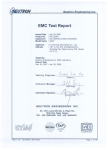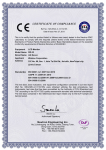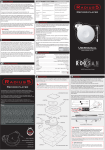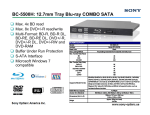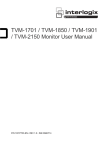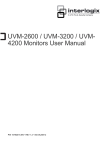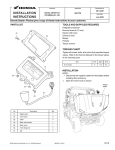Download LP-17 & LP-19 User Manual
Transcript
FEDERAL COMMUNICATIONS COMMISSION RADIO FREQUENCY INTERFERENCE STATEMENT NOTE : This equipment has been tested and found to comply with the limits for a Class A digital device, pursuant to Part 15 of the FCC Rules. These limits are designed to provide reasonable protection against harmful interference in a commercial installation. This equipment generates, uses and can radiate radio frequency energy and, if not installed and used in accordance with the instructions, may cause harmful interference to radio communications. However, there is no guarantee that interference will not occur in a particular installation. If this equipment does cause harmful interference to radio or television reception, which can be determined by turning the equipment off and on, the user is encouraged to try to correct the interference by one or more of the following measures : - Reorient or relocate the receiving antenna. - Increase the separation between the equipment and receiver. - Connect the equipment to an outlet on a circuit different from that to which the receiver is connected. - Consult the dealer or an experienced radio or TV technician for help. CAUTION : Any changes or modifications not expressly approved by the party responsible for compliance could void the user’s authority to operate the equipment. CANADIAN NOTICE This Class A digital apparatus meets all requirements of the Canadian Interference-Causing Equipment Regulations. AVIS CANADIEN Cet appareil numérique de la Class A respecte toutes les exigences du Règlement sur le matériel brouilleur du Canada. European Union Notice Products with the CE Marking comply with both the EMC Directive (89/336/EEC) issued by the Commission of the European Community. Compliance with these directives implies conformity to the following European Norms (in brackets are the equivalent international standards): • EN55022 (CISPR 22) - Electromagnetic Interference • EN55024 - Immunity Test for ITE Product • EN61000-3-2 (IEC555-2) - Power Line Harmonics WARNING: FOR CONTINUED SAFETY, REPLACE POWER ADAPTOR ONLY WITH MANUFACTURER'S RECOMMENDED MODELS 3 CONTENTS Introduction ............................................................................. 5 Product Features ...................................................................... 6 Remote Control ........................................................................7 Setup ......................................................................................... 9 Operation & Adjustment .......................................................11 OSD Function .........................................................................14 Specifications .......................................................................... 24 Troubleshooting ..................................................................... 25 4 INTRODUCTION This manual explains how to correctly install, operate and get the best performance from your monitor. Please read this Installation Manual carefully before installing your monitor, then keep it near your monitor for quick reference. First, please check that the contents of the box corresponds with the following checklist : • TFT LCD Monitor • Power Cord • RCA Cable • 15 Pin Signal Cable • Installation Manual • AC Adapter • Remote Controller If any item is missing or damaged, please contact your distributor Please keep the box and packing materials so that you may properly store or transport your monitor. 5 PRODUCT FEATURES The convenient and user-friendly on-screen display allows for easy and accurate adjustments of screen size, position and screen color. The monitor complies with the VESA Display Data Channel (DDC) specification for Plug and Play compatibility. Advanced microcircuitry makes setup and configuration fast and effortless. The monitor features Advanced Color Controls for fine-tuning to meet your own personal tastes or application requirements. Use the on-screen controls to adjust the color temperature, RGB gain value for the best possible screen color and intensity. Press the menu button and activate the Self-Diagnosis menu to determine whether your monitor is functioning normally, not receiving a signal or is receiving a signal that is out of scanning range. Activate the higher refresh rates of the monitor to stabilize the screen and eliminate the annoying flicker that contributes to eye-strain and headaches. 6 REMOTE CONTROL R1 POWER ·Turns the set on from stand-by or odd to Stand-by mode. R2 INPUT SOURCE ·Select the signal source from the multiple input sources. R3 MUTE ·Turns the sound on and off R4 NUMBER Button ·Unavailable. R5 LAST CH ·Unavailable. R6 INFORMATION ·Information display. R7 PICT Mode ·Recalls your preferred picture settings. R8 SLEEP ·Sets the sleep timer. R9 MENU ·Display a main menu. R10 EXIT ·Turns the OSD window off and moves from sub Menu to top menu in the OSD window. R11 / R17 UP/DOWN / Button ·Adjust the main or camera menu setting. R12 / 14 LEFT/RIGHT / Button ·Adjust the main or camera menu setting. 7 R13 OK ·Select menu items. R15 VOL +/·Adjust the sound level R16 PR +/·Unavailable. R18 PC R19 S MODE ·Choose different preset sound mode or your owncustomized sound. R20 AUTO ·Choose automatically the proper horizontal Position andvertical position & size of the screen image. R21 ·Unavailable. R22 POSITION ·Select the position of PIP display. R23 ZOOM ·Select the ZOOM or FULL mode. R24 SIZE ·Select the size of PIP display. R25 SKIP ·Unavailable. R26 PIP ·Activate or cancel the PIP function. R27 S. SWAP ·Change the sound source of the main or sub display. R28 SOURCE ·Select the signal source of the sub display. R29 P. SWAP ·Change the picture of the main or sub display. R30, R31,R32,R33 ·Unavailable. Inserting batteries into the Remote Control unit To load the batteries turn the remote control handset over and open the battery compartment. Insert the batteries (2x 1.5v type R03 or AAA). Make sure that the polarity matches with the (+) and (-) marks inside of the battery compartment. Note : To avoid damage from possible battery leakage, remove the batteries if you do not plan to use the remote control handset for an extended period of time. 8 SETUP CONNECTING THE 15 PIN SIGNAL CABLE AND POWER CORD ① Turn off the DVR and monitor. ② Connect the 15 pin signal cable to the appropriate VGA port located at the back of your DVR and the security monitor panel. ③ Connect the DVI cable to the appropriate DVI port located at the back of your DVR and the security monitor panel. (Optional) ④ Connect the audio cable to the audio output port located at the back of your DVR. (Optional) ⑤ Plug the DC jack into the DC in port located on the back of the monitor. ⑥ Plug the power cord into the AC receptacle of the Adapter. ⑦ Plug the other end of the power cord into the AC outlet. 9 CONNECTING THE OTHERS DC input Line in Line out DVI-D input Analog signal input (15 pin) Component input AV input 1 (stereo), AV output 1 (Mono) AV input 2 (stereo), AV output 2 (Mono) S-Video input/output Camera input Audio input for video source Video source should be mached as below Audio 1 : AV1, S-video, CAM IN Audio 2 : AV2 10 OPERATION & ADJUSTMENT CONTROL PANEL 1 POWER Switches the monitor on and off. 5 Down Arrow Primary Function: Unavailable Secondary Function: Allows for Vertical scrolling in the OSD Main Menu. 2 Right Arrow - Volume Primary Function: Used to INCREASE the volume. Secondary Function: Allows for Horizontal scrolling in the OSD Main Menu, and to INCREASE the value of the selected submenu function. 6 SOURCE Used to select from different input sources. Press the UP or DOWN arrow to scroll through the available sources, and press LEFT or RIGHT arrow to confirm selection. 3 Left Arrow - Volume Primary Function: Used to DECREASE the volume. Secondary Function: Allows for Horizontal scrolling in the OSD Main Menu, and to DECREASE the value of the selected submenu function. 7 MENU Primary Function: Launches the OSD main menu. Secondary Function: Used to exit out of OSD Main menu or Sub-menu. 4 Up Arrow - Auto Adjustment Primary Function: Automatically adjusts the display to the most optimal setting possible. Secondary Function: Allows for Vertical scrolling in the OSD Main Menu. 11 KEY PROCESS < MENU > ① Press MENU to launch the OSD(On-Screen Display) Main Menu. ② Use LEFT or RIGHT arrow to scroll horizontally, and UP or DOWN arrow to scroll vertically through the available functions and options. ③ Make the desired adjustment using the LEFT or RIGHT arrows, then press MENU to exit out of current menu. ④ Press MENU again to confirm all changes and to exit out completely. < SOURCE > ① Press SOURCE to launch the OSD(On-Screen Display) Menu. ② Use UP or DOWN arrow to scroll vertically through the available input sources. ③ Press LEFT or RIGHT arrow to confirm selection. 12 ADJUSTMENT PROCEDURE < PC Mode > Perform the Auto tracking No Is the H.SIZE proper? Adjust the CLOCK control. Yes Perform the AUTO POSITION. Is the noise displayed on the screen? Yes Adjust the CLOCK FINE until the screen is cleared. Is the noise displayed on the screen yet? No End Yes 13 OSD FUNCTION PC/DVI Mode OSD Menu P C 1. Contrast Adjust the contrast of image, the difference between light and dark areas on the screen. 2. Brightness Adjust the brightness of image. 3. Color Mode Choose different preset color temperatures or set your own customized color parameters. (Normal/Warm/Cool/User) 4. Scale This function is currently unavailable for this model. 5. Auto Choose automatically the proper horizontal Position and vertical position & size of the screen image. Sound 1. Bass When you select the user mode, adjust the bass sound. 2. Treble When you select the user mode, adjust the treble sound. 3. Balance Adjust the sound balance of the left and right speakers. 4. MTS This function is currently unavailable for this model. 5. Sound Mode Choose different preset sound mode or your own customized sound.(Standard/Movie/Music/User) 14 Geometry 1. H-Position Adjust the position of the display horizontally (left or right). 2. V-Position Adjust the position of the display vertically (up or down). 3. Clock Adjust the width (horizontal size) of the Screen image. 4. Phase Remove any horizontal noise and clear or sharpen the image of characters. System 1. Sleep Timer Select time to turn off the monitor. (Off/15/30/45/60 Minutes) 2. Language Select language for OSD. 3. OSD H-Position Adjust the OSD position of the display horizontally (left or right). 4. OSD V-Position Adjust the OSD position of the display vertically (up or down). 5. OSD Timeout Adjust the display OSD Menu. (5~60 Second) 6. OSD Transparency Adjust the OSD. Transparency 7. Information Display horizontally and vertically frequency of monitor. 8. Memory Recall Reset the screen to the Factory Preset Display Settings. 9. Light Sensitivity If the sensed light level is below the set level, the monitor is turned off. Choices range from "Low" (for darker environments) to "High" (for brighter environments). Default is "Off". 10. Camera Menu This function is currently unavailable for this model. 15 PIP 1. Multi Window Activate or cancel the PIP function. 2. Sub Source Select the input source the PIP screen. 3. Size Select the PIP display size. (Small/Middle/Large/Double 1/Double 2) 4. Position Adjust the PIP display position. (R-Up/R-Down/L-Down/L-Up) 5. Border Color Select the border color of the PIP display. (Black/Blue) 6. Sound Swap Select the sound source. (Main/Sub) 7. Picture Swap Change the main picture and the sub pictures of the PIP. 16 Sequence 1. AV Program The default setting is set to 'OFF' This function is currently unavailable for this model. 17 AV1/AV2/SVIDEO/COMPONENT Mode OSD Menu Picture 1. Contrast Adjust the contrast of image, the difference between light and dark areas on the screen. 2. Brightness Adjust the brightness of image. 3. Tint Adjust the tint of image. 4. Color Adjust color of image. 5. Sharpness Adjust the display image quality (if the screen proceed to scaling up). 6. Color Tone Choose different preset color temperatures or set your own customized color parameters. (Normal/Warm/Cool) 7. Picture Mode Select the picture mode. (Standard/Movie/Dynamic/User) 8. Screen Format Select the aspect ratio. Sound 1. Bass When you select the user mode, adjust the bass sound. 2. Treble When you select the user mode, adjust the treble sound. 3. Balance Adjust the sound balance of the left and right speakers. 4. MTS This function is currently unavailable for this model. 5. Sound Mode Choose different preset sound mode or your own customized sound.(Standard/Movie/Music/User) 18 Function 1. 3D NR. Reduce the noise in the picture due to poor reception or poor picture quality. Function (Off/Low/Middle/High) 2. MADi Generation advanced color engine automatic picture enhancement gives. (2D/3D) 3. H-Size Adjust the width (horizontal size) of the Screen image. 4. V-Size Adjust the height (vertical size) of the Screen image. 5. H-Position Adjust the position of the display horizontally (left or right). 6. V-Position Adjust the position of the display vertically (up or down) 19 System 1. Sleep Timer Select time to turn off the monitor. (Off/15/30/45/60 Minutes) 2. Language Select language for OSD. 3. OSD H-Position Adjust the OSD position of the display horizontally (left or right). 4. OSD V-Position Adjust the OSD position of the display vertically (up or down). 5. OSD Timeout Adjust the display OSD Menu. (5~60 Second) 6. OSD Transparency Adjust the OSD. Transparency 7. Information Display horizontally and vertically frequency of monitor. 8. Memory Recall Reset the screen to the Factory Preset Display Settings. 9. Light Sensitivity If the sensed light level is below the set level, the monitor is turned off. Choices range from "Low" (for darker environments) to "High" (for brighter environments). Default is "Off". 10. Camera Menu This function is currently unavailable for this model. 20 PIP 1. Multi Window Activate or cancel the PIP function. 2. Sub Source Select the input source the PIP screen. * Refer to PIP table.(page 22) 3. Size Select the PIP display size (Small/Middle/Large/Double 1/Double 2) 4. Position Adjust the PIP display position. (R-Up/R-Down/L-Down/L-Up) 5. Border Color Select the border color of the PIP display. (Black/Blue) 6. Sound Swap Select the sound source. (Main/Sub) 7. Picture Swap Change the main picture and the sub pictures of the PIP. 21 Sequence 1. AV Program The default setting is set to 'OFF' This function is currently unavailable for this model PIP TABLE MAIN D-SUB DVI AV* COMPONENT D-SUB - X X S DVI X - X U AV B COMPONENT X X : Supported X : Non Supported AV* : AV1,AV2,CAM IN,SVIDEO 22 - SELF DIAGNOSIS If there is no image, the Self Diagnosis screen will be displayed. Self Diagnosis function checks if the status of the monitor screen is No Signal, Out of range or None support. No Signal screen is displayed when the DSub signal connector is connected but the status of the monitor is on DPMS mode. Out of Range screen is displayed when the applied frequency is under or over normal range. Normal range (Non-interlaced mode only) H : 30 - 80 KHz V : 56 - 77 Hz Check cable screen is displayed when the signal cable is disconnected. 23 SPECIFICATIONS SPECIFICATIONS Panel Size Pixel Pitch Resolution Viewing Angel Contrast Ratio Picture Response Time 3D Comb Filter Video Format Interface VGA In DVI In Composite In/Out(BNC) Spot Out (RCA) S-Video In/Out Component In Audio In/Out GENERAL Housing Type Rack Mount Kits Dimensions(W D H) Weight Input Power LP-17 LP-19 17.0 inch 19.0 inch 0.264mm 0.264 mm 0.294mm 0.294 mm 1280 1024 160°(H) / 160°(V) 1000:1 5ms Yes NTSC/PAL (Auto Detect) 1 1 2/2 1 1/1 1 2/2 LP-17 LP-19 Metal Optional 373mm 73mm 385mm 411mm 74mm 377mm 6.5Kg 6.85Kg DC 12V, 3.33A 24 TROUBLESHOOTING Symptom Check Picture is jitterd. Adjust Clock to set the screen position and adjust Clock fine until a noise isn’t displayed. No picture. Check if power switch and computer power switch are in the on position. Check if the signal cable is correctly connected to the video card. Check if the pins of D subconnector are not bent. Check if the computer is in the power- saving mode. POWER LED is not Check if power switch is in the on position. lit. Check if the power cord is correctly connected. Image is unstable. Check if the signal cable is suitable to the video card. Image is not centered, too small or too large. Adjust Clock or H&V Center to get the proper image. Picture bounces or a Keep the devices that may cause electrical wave pattern is interference away from the monitor. present in the See the FCC information at the front cover of the picture. manual. Picture is blurred. Adjust Contrast and Brightness. 25 Symptom Low sound. Adjust the volume on the OSD Menu. Adjust the volume of the sound card in the computer. VIDEO screen cannot be seen. Check if VIDEO mode has been set. Check if the video terminal is properly connected. No video. Check if the video cable is correctly connected to the computer and set to the video mode. Poor color in the video. Adjust the Saturation or Hue on the OSD Menu in the video mode. Grainy picture in the Adjust the Sharpness on the OSD Menu in the video video. mode. 26 S/N:9978641806

































